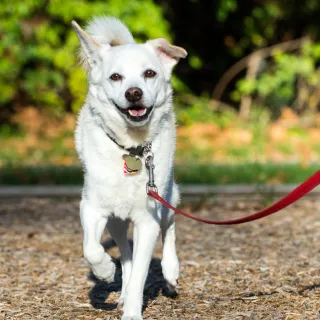The Grey Hairs: Advice from My Grandmother by Katie Kapro
My grandmother’s dog Mickey, a whippet-chihuahua mix, has the personality of a bouncer and the plump, muscular build of a chicken breast with legs. My grandmother Binkie has a fragile build—knobby joints and slender wrists—suited to her 90 years. They are an unusual and somehow perfectly suited pair.
Mickey came into Binkie’s life soon after her 84th birthday. He was the product of divorce, abandoned with a friend who owns a kennel. At the same time, Binkie had a whole quiet house to herself. Her husband died of Parkinson’s disease 30 years earlier, and all of her kids and grandkids were grown. After an initial week of skittishness, Mickey settled right in with Binkie. He claimed a corner of her bed, learned that one yip at the backdoor would beckon her posthaste, and discovered that his favorite perch is her lap. Whether she’s sitting at the table, watching football in the reclining chair, or rocking in the living room, Mickey will leap onto her legs and sit alert while she strokes his back.
When Binkie brought Mickey home he was just beginning to show the first signs of grey around his muzzle. Today he has all the telltale colorings of age around his nose, ears, and brows. They are growing elderly together.
Mickey was overweight when he first came to Binkie. Being a product of a Southern California farm family during the Great Depression, Binkie had no problem getting him down to a healthy weight. His veterinarian actually challenged them to a contest with several other families—the dog who lost the highest percentage of excess body fat would win a lifetime supply of dog food. Binkie put Mickey on a Depression diet and they won. The funny thing is, through the course of the diet she found that Mickey was exceedingly fond of steamed green beans and carrots, so it will take them a long time to work through the prize kibble.
Their mealtime ritual is something to behold. Promptly at 4:15 every afternoon, Mickey click-clacks into the kitchen and yaps that he’s ready for his dinner. Binkie will have already chopped the vegetables and have them in the steamer. She’ll generally wag a finger at him or put her hands on her hips and chastise him for being so impatient. His response is to prance around the linoleum for a moment and wait at his food dish. After the veggies have cooled, she’ll dish up his serving and he’ll gobble it down, carefully plucking each carrot from the dish and carrying it to the living room to eat first.
Inevitably, he will bark for a second helping and a hilarious monologue about being spoiled ensues.
Shortly after dinner, it’s time for their nightly walk around the neighborhood. Often owners of senior dogs stop exercising their pets for fear of exacerbating their injuries and ailments, but as a senior herself, Binkie knows that the solution to an aging body isn’t lethargy. She still gets regular exercise and has an active social life, so why wouldn’t her dog?
Another aspect of Binkie’s age that makes her an attentive senior dog parent is that she has come to terms with the inevitable fact that every life will end, including her own. It’s not an abstraction for her. She has attended more funerals than I have friends. She has mourned the deaths of family, friends, and almost every popular icon that she knew as a girl.
It leads one to develop a certain practicality.
While Binkie’s children were growing up, she worked as a legal assistant. She witnessed firsthand the value of planning ahead for all the sundry legal issues one’s family is left negotiating after their death. Pet care, it turns out, is something that often gets overlooked.
People just assume that someone in their family will step in and care for their beloved pet. Unfortunately, that’s not the case. Senior dogs especially have a troubled time in this regard—if they have health issues it’s less likely that someone will volunteer to take on the animal and all their expenses.
So what’s the most practical course of action?
Most states make it easy to set up a pet trust for an animal in the case of your death. While a will can take months to enact, leaving the animal stranded, a pet trust can be enacted immediately.
The basic premise is that the owner chooses a friend or family member as a pet trustee, sets aside money to help with expenses, and records daily care information like routines and veterinary details. Quite possibly the most valuable part of the process is that it’s a formal way to have a conversation with someone who is willing to care for the pet. It’s a means for having a discussion that is innately uncomfortable, but entirely necessary for the well-being of the animal.
Binkie and Mickey, both bona fide senior citizens, don’t spend all their time thinking about death. At least she doesn’t. I can’t say for sure that Mickey doesn’t, but I’m pretty sure dog treats win that spot. Binkie has had a lot of practice with aging, and she understands better than most just how important it is to prepare for the practical realities of life and death.
The best life advice I ever got from Binkie? Live every moment to its fullest and take care of the people, and animals, you love.
Binkie and Mickey are not alone in their bond. How have dogs bettered the lives of seniors in your life?




